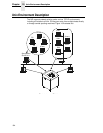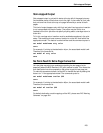
198
Chapter 10 Unix Host Configuration
HP-UX Configuration Guidelines
Within SAM follow the menu:
Printers and Plotters
Printers/Plotters
Printer/Plotter Manager menu ... select Actions
Add Local Printer/Plotter
Add parallel Printer/Plotter or
Add serial Printer/Plotter
If parallel printer is selected:
Printer Name user's choice
Printer Model Interface user's choice
Printer Device File Name SAM creates a special file
Printer Class user's choice
If serial printer is selected:
The system displays the Serial Interface Hardware Paths
Port select a valid port
Printer Name user's choice
Printer Model Interface user's choice
Printer Device File Name SAM creates a special file
Printer Class user's choice
Printing Setup On Sys V
This setup involves any Unix operating system using System V print spooling
(e.g., SCO, Solaris
, DG/UX , Sun 2.5.x, 2.6, 2.7 and similar, etc.). This
means an interface file is used for each defined printer and in the case of any
System V print setup involving a NIC, the RSHD protocol is used to transfer
data from the host to the print server.
To manually configure a new System V printer on a Unix station, create a
dummy device file that acts as a locking mechanism between contending print
jobs.
Sys V printing is characterized by use of the lp printer interface program,
lpsched
printer scheduler, and the use of an interface file. The file
lpadmin
is used in setting up the print queue definition. As of Sun 2.6 and on, the
interface file
netstandard
is provided in a generic interface file intended for
network print servers such as the NIC. Also as of Sun 2.6 the ability to print to
a socket (sometimes called raw tcp) or a remote printer (
dest
for P5000LJ) is
provided.
Root access is required to use
lpshut
(stop the print scheduler to add a new
printer with
lpadmin
),
lpsched
and
lpadmin
.
For the following example, assume the print queue to be created is
lobby
,
and the ping-able IP Address name of the P5000LJ is
LJ_PS1
, and you wish
to print to remote printer (dest)
d1prn
on LJ_PS1. As always with Unix,
commands are case-sensitive. Also, be sure to use the
bourne
or
korn
shell,
not the
cshell
when using the commands.


















